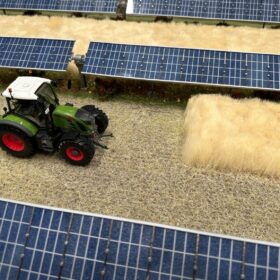Ecoprogetti releases fully automated solar panel recycling line
Italy’s Ecoprogetti has developed an automated photovoltaic recycling line that separates and recovers up to 100% of the aluminum, copper, glass, plastic and silicon in solar panels. It can process up to 60 panels per hour while using 40% less energy than other solutions on the market.
Italy installs 1.24 GW of solar in Q1
Italy installed 1.24 GW of new solar capacity in the first quarter, a 19% decline from the same period in 2024, according to renewables association Anie Rinnovabili. The slowdown highlights mounting headwinds in the country’s PV market.
Waaree Energies acquires Enel Green Power’s India arm
Waaree Energies Ltd has signed a definitive agreement to acquire 100% of Enel Green Power India (EGP India) for INR 792 crore.
Italy allocates 1.5 GW in agrivoltaics tender
The Italian authorities have chosen 540 projects, totaling 1.5 GW, in the nation’s first agrivoltaics tender.
Ecoprogetti delivers 300 MW solar panel production line to SAEL
SAEL’s production line from Italy’s Ecoprogetti is equipped to produce double-sided glass-glass solar panels using TOPCon M10 cells.
Amara Raja secures lithium battery, EV charger deal with Piaggio India
Amara Raja has signed the agreement to develop and supply lithium-ion cells, battery packs, and chargers for Piaggio electric vehicles in India.
REC secures JPY 60.5 billion green loan backed by Italian export credit agency SACE
REC will use the funding to support projects which meet rigorous environmental standards, promote renewable energy and contribute to reducing carbon emissions.
Webdyn India crosses 4.2 GW mark, Fimer supplies inverters for solar-plus-storage project
Webdyn’s Indian unit has supplied remote monitoring tech and hybrid power management solutions for 4.2 GW of solar plants since 2015, while Italian inverter maker Fimer has supplied its 1 MVA inverters for a new integrated solar-plus-storage project in Gujarat.
Enel joins the Indian solar gold rush
The Italian utility, fresh from securing its first 300 MW of PV generation capacity in the recent, record-setting tender held by SECI, has teamed up with the state-owned Norwegian Investment Fund to commit to further clean energy facilities in India.
Italian inverter maker confirms no ABB jobs will be lost in India
Fimer’s takeover of the inverter business of the Swiss conglomerate will not affect job numbers at ABB’s Indian production facilities, according to the new owner of the combined business.















